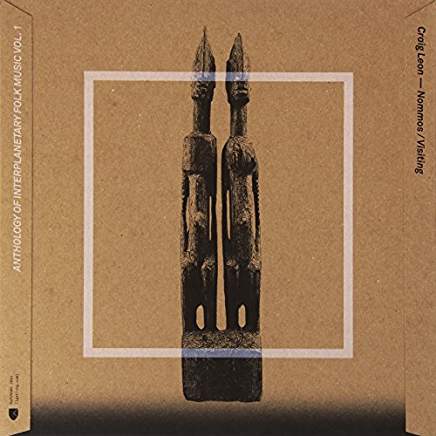
Some time in the late 1970s—the decade during which he’d produced groundbreaking debut records by Suicide, the Ramones, Richard Hell, and Blondie—Craig Leon went to see an exhibit of ancient art made by a tribe from Mali, the Dogon. Although their people have lived in relative seclusion for centuries, their ancestors developed an impressively complex system of astronomy. The Dogon worship amphibious, extraterrestrial creatures called Nommos, who are believed to have travelled to earth from the distant star Sirius B. All of which might sound a little out there—until you learn that in the 20th century, modern astronomers were astonished to find how accurate the Dogon’s ancient calculations were; somehow, centuries before telescopes, their ancestors had identified stars that were invisible to the naked eye. Leon was as taken with this mystery as he was with his growing collection of synthesizers. He decided to make an album of what he imagined would be playing “on the Nommos’s Walkman” (“They would have had to listen to something on an interplanetary flight… otherwise it would have been very boring”) and, in a cosmic nod to Harry Smith, give it the playful title Anthology of Interplanetary Folk.
The resulting collection is a masterpiece of early electronic music—a precursor to later explorations in industrial music, new age, and ambient techno—but up until now, it’s never been heard exactly how Leon intended. Leon composed the Anthology as two “mirror image” parts: The driving and metallic Nommos came out on John Fahey’s Takoma label as a standalone LP in 1981, and its sequel, the softer and more subdued Visiting came out a year later. In the decades it’s been out of print, Nommos in particular has been bootlegged repeatedly, and late last year the California label Superior Viaduct put out a reissue of Nommos against Leon’s wishes. “I had always envisioned a different version of the album being the definitive version,” Leon said, and so the 2013 release spurred him into taking control of the record’s legacy. This new authorized reissue, put out with care by the Brooklyn label RVNG, finally presents Leon’s otherworldly achievement exactly as he wanted it to be heard, with Nommos and Visiting side by side for the first time.
A cliche you often hear about early synth-based music is that it “still sounds like something from the future,” but what’s interesting about Anthology is that it was always meant to sound like a transmission from the past. As his invented genre of “interplanetary folk” attests, Leon was drawn to the interplay of apparent opposites: antiquity and progress, earth and space, and, of course, new age and punk. Anthology is not an anthropological attempt to replicate (or colonize) the sounds of the Dogon tribe, but rather something more creative and personal—a sonic work of speculative fiction that uses “new” technology to imagine a time before recorded music. Neither primitive nor futuristic, it still has this uncanny feel of music that exists somewhere outside of time.
The atmosphere of Nommos is clanging and aqueous (because the Nommos could swim, Leon wanted to make it sound like music heard underwater). Driven by a mesmerizing polyrhythmic beat, “Donkeys Bearing Cups” is punctuated by sudden spurts of jagged-aluminum synths, while the incandescent “Nommo” lulls you into a gentler (though no less immersive) trance. Anthology’s centerpiece is Nommos‘ penultimate track, the haunting 15-minute reverie “Four Eyes to See the Afterlife”, the last two-thirds of which build on a tinny loop and a wordless, interplanetary siren song voiced by Leon’s wife and collaborator Cassell Webb.
Although it still captures a feeling of intergalactic awe, Visiting is meant to evoke a more terrestrial vibe than its companion piece. The bright and lively “Region of Fleeing Civilians” is the closest the collection comes to a straight-ahead synth-pop instrumental (complete with percussion that sounds like handclaps), and “Visiting” introduces a tranquilly lilting guitar into the atmosphere. As far as its earth-bound kindred spirits go, Anthology sounds attuned to the frequencies that had been coming out of Germany that decade: Nommos‘ “She Wears a Hemispherical Skullcap” has an “Autobahn”-esque luminosity about it, while Anthology’s more muted moments echo Brian Eno’s work with Cluster. Still, as Leon explains, the spirit of New York punk is pulsing through it, too. “The Lower East Side scene was very involved in counterculture art and poetry,” he recalled in a recent interview. “It became populist later, but if you look at Patti Smith, Television, Talking Heads, even the Ramones… Nommos fit in with that.”
The timing of this reissue couldn’t be better. We’re in middle of a modest but notable new age revival, when a new generation of listeners are reassessing this often-misunderstood genre, discovering its pioneers, and uncovering its hidden DIY roots. Leon is a perfect embodiment of new age’s unexpected punk past, and it would seem the world is only now catching up with his vision, over thirty years after his Anthology was released. A few months ago, I had the pleasure of seeing Leon play Nommos in full at the Greenwich Village venue Le Poisson Rouge, a short walk from the downtown clubs where he first saw Suicide and Patti Smith decades ago. His set featured spacey visual projections, and he and Webb were joined by the stylistically adventurous string ensemble ACME—which, actually, was how he envisioned this supposed synth-classic all along. “It was meant to be orchestral,” he admitted in a recent interview, “but we didn’t have any money!” Like these performances, the definitive reissue finally brings Leon’s landmark work full circle. Anthology of Interplanetary Folk is far from some kitschy relic of electronic music past; in fact, there may have never been a better time to join Leon for the ride.
